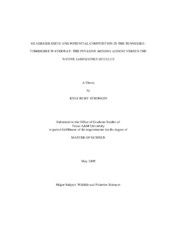| dc.contributor.advisor | Neill, William H. | |
| dc.creator | Strongin, Kyle | |
| dc.date.accessioned | 2010-07-15T00:12:58Z | |
| dc.date.accessioned | 2010-07-23T21:44:21Z | |
| dc.date.available | 2010-07-15T00:12:58Z | |
| dc.date.available | 2010-07-23T21:44:21Z | |
| dc.date.created | 2009-05 | |
| dc.date.issued | 2010-07-14 | |
| dc.date.submitted | May 2009 | |
| dc.identifier.uri | https://hdl.handle.net/1969.1/ETD-TAMU-2009-05-600 | |
| dc.description.abstract | I investigated dietary differences, overlap and shifts for two atherinid fish species inhabiting the highly modified Tennessee-Tombigbee Waterway (TTW) in Mississippi, U.S.A. The Mississippi silverside (Menidia audens) is now common throughout the waterway and apparently invaded from the Tennessee River after man-made connection with the Tombigbee River in the mid 1980s. A subsequent decline in the distribution and abundance of the native brook silverside (Labidesthes sicculus) led to speculation that dietary competition might be involved. I used extant data to test the null hypotheses that diets are not different between the two silverside species in TTW, that dietary overlap between them is random and that no dietary niche shift occurs for either species in the presence or absence of its putative competitor. I accomplished this by quantifying the diet of both species from sympatric and allopatric collections, then using multivariate statistics and null models to test for significant dietary differences, overlap, and niche shifts. The analysis indicated that diets differed significantly between the two species. However, dietary overlap at sites of co-occurrence was greater than expected under conditions of incipient competitive exclusion; and, dietary niche shifts were not found when the diet of either species in allopatric collections was compared to its diet in sympatric collections. Thus, there was no evidence for direct involvement of dietary competition in the population trends of silversides in the Tennessee-Tombigbee Waterway. Yet, it appears that M. audens is replacing L. sicculus in dominant habitats of TTW, just as has happened in other, similar systems. Simulations with STELLA� were used to estimate the degree of inter-specific competition that might account for observed rates of replacement. Results implied a 10 % ecological advantage of M. audens over L. sicculus. | en |
| dc.format.mimetype | application/pdf | |
| dc.language.iso | eng | |
| dc.subject | Silversides, competition, Tombigbee Waterway | en |
| dc.title | Silverside Diets and Potential Competition in the Tennessee-Tombigbee Waterway: The Invasive Menidia audens versus the Native Labidesthes sicculus. | en |
| dc.type | Book | en |
| dc.type | Thesis | en |
| thesis.degree.department | Wildlife and Fisheries Sciences | en |
| thesis.degree.discipline | Wildlife and Fisheries Sciences | en |
| thesis.degree.grantor | Texas A&M University | en |
| thesis.degree.name | Master of Science | en |
| thesis.degree.level | Masters | en |
| dc.contributor.committeeMember | Taylor, Christopher M. | |
| dc.contributor.committeeMember | Wicksten, Mary | |
| dc.contributor.committeeMember | Gelwick, Frances | |
| dc.type.genre | Electronic Thesis | en |
| dc.type.material | text | en |


